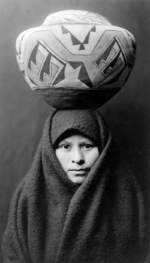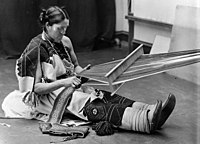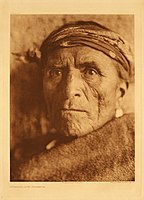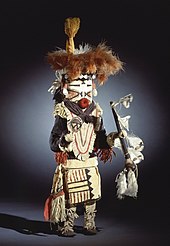This is an old revision of this page, as edited by Indigenous girl (talk | contribs) at 02:55, 4 November 2021 (Undid revision 1053463956 by 2600:8800:521F:EF00:6C8C:2553:49C0:B8BC (talk)). The present address (URL) is a permanent link to this revision, which may differ significantly from the current revision.
Revision as of 02:55, 4 November 2021 by Indigenous girl (talk | contribs) (Undid revision 1053463956 by 2600:8800:521F:EF00:6C8C:2553:49C0:B8BC (talk))(diff) ← Previous revision | Latest revision (diff) | Newer revision → (diff) Native American Pueblo peoples native to the Zuni River valley Ethnic group Zuni girl with jar, 1903 Zuni girl with jar, 1903 | |
| Total population | |
|---|---|
| 19,228 enrolled members (2015) | |
| Regions with significant populations | |
| United States (New Mexico) | |
| Languages | |
| Zuni, English, Spanish | |
| Related ethnic groups | |
| Pueblo people |

The Zuni (Template:Lang-zun; formerly spelled Zuñi) are Native American Pueblo peoples native to the Zuni River valley. The current day Zuni are a Federally recognized tribe and most live in the Pueblo of Zuni on the Zuni River, a tributary of the Little Colorado River, in western New Mexico, United States. The Pueblo of Zuni is 55 km (34 mi) south of Gallup, New Mexico. The Zuni tribe lived in multi level adobe houses. In addition to the reservation, the tribe owns trust lands in Catron County, New Mexico, and Apache County, Arizona. The Zuni call their homeland Halona Idiwan’a or Middle Place. The word Zuni is believed to derive from the Western Keres language (Acoma) word sɨ̂‧ni, or a cognate thereof.
History
Archaeology suggests that the Zuni have been farmers in their present location for 3,000 to 4,000 years. It is now thought that the Ancestral Zuni people have inhabited the Zuni River valley since the last millennium B.C., at which time they began using irrigation techniques which allowed for farming maize on at least household-sized plots.

Zuni culture was preceded by Mogollon and Ancestral Pueblo peoples cultures, who lived in the deserts of New Mexico, Arizona, Utah, and southern Colorado for over two millennia. White Mound was one such settlement of pit houses, farming, and storerooms, built around 700 A.D., followed by the village of Kiatuthlanna around 800 A.D., and Allantown around 1000 A.D. These Mogollon villages included kivas. Likewise, Zuni ancestors were in contact with the Anasazi at Chaco Canyon around 1100. The Zuni settlement called Village of the Great Kivas, was built around 1100, and included nine kivas. The Zuni region, however, was probably only sparsely populated by small agricultural settlements until the 12th century when the population and the size of the settlements began to increase. The large villages of Heshot Ula, Betatakin, and Kiet Siel were established by 1275. By the 13th century villages were built on top of mesas, including Atsinna on Inscription Rock. In the 14th century, the Zuni inhabited a dozen pueblos between 180 and 1,400 rooms in size, while the Anasazi abandoned larger settlements for smaller ones, or established new ones along the Rio Grande. The Zuni did move from the eastern portion of their territory to the western side, and built six new villages, Halona, Hawikuh, Kiakima, Matsaki, Kwakina, and Kechipaun. Halona was located 97 km north Zuni Salt Lake, and the Zuni traded in salt, corn and turquoise. Hawikuh was claimed by Niza to be one of the Seven Cities of Cibola, a legendary 16th century wealthy empire.
In 1539, Moorish slave Estevanico led an advance party of Fray Marcos de Niza's Spanish expedition. Sponsored by Antonio de Mendoza who wanted Niza to "explain to the natives of the land that there is only one God in heaven, and the Emperor on earth to rule and govern it, whose subjects they all must become and whom they must serve." The Zuni reportedly killed Estevanico as a spy, or for being "greedy, voracious and bold." This was Spain's first contact with any of the Pueblo peoples. Francisco Vásquez de Coronado expedition followed in the wake of Niza's Seven Cities of Cibola claim. Sponsored once again by Mendoza, Coronado led 230 soldiers on horseback, 70 foot soldiers, several Franciscan priests and Mexican natives. The Spanish met 600 Zuni warriors near Hawikuh in July 1540, inflicting several casualties, and capturing the village. Coronado continued onwards to the Rio Grande, but several priests and soldiers stayed an additional 2 years. The Chamuscado and Rodríguez Expedition followed in 1581, and Antonio de Espejo in 1583. Juan de Oñate visited Zuni territory in 1598 and 1604 looking for copper mines, but without success. Francisco Manuel de Silva Nieto established a mission at Hawikuh in 1629 with 2 Franciscan priests. They completed a church compound in 1632, and established a second mission in Halona. Shortly afterwards, the Zuni destroyed the missions, killing two priests, and then retreated to Dowa Yalanne, where they remained for the next three years. The Spanish built another mission in Halona in 1643.
Before the Pueblo Revolt of 1680, the Zuni lived in six different villages. After the revolt, until 1692, they took refuge in a defensible position atop Dowa Yalanne, a steep mesa 5 km (3.1 miles) southeast of the present Pueblo of Zuni; Dowa means "corn", and yalanne means "mountain". After the establishment of peace and the return of the Spanish, the Zuni relocated to their present location, returning to the mesa top only briefly in 1703. By the end of the 17th century, only Halona was still inhabited of the original six villages. Yet, satellite villages were settled around Halona, and included Nutria, Ojo Caliente, and Pescado.
Of the three Zuni missions, only the church at Halona was rebuilt after the reconquest. According to Nancy Bonvillain, "Indeed, by the late eighteenth century, Spanish authorities had given up hope of dominating the Zuni and other western Pueblo Indians, and in 1799 only seven Spanish people were recorded as living among the Zuni." In 1821, the Franciscans ended their missionary efforts.
In 1848, U.S. Army Lt. Col. Henderson P. Boyakin signed a treaty with Zuni and Navajo leaders stating the Zuni "shall be protected in the full management of all their rights of Private Property and Religion... the authorities, civil and military, of New Mexico and the United States." Observing the Zuni in the 1850s, Balduin Möllhausen noted "In all directions, fields of wheat and maize, as well as gourds and melons, bore testimony to their industry."
The Zuni Reservation was created by the United States federal government in 1877, and subsequently enlarged by a second Executive order in 1883.
Frank Hamilton Cushing, an anthropologist associated with the Smithsonian Institution, lived with the Zuni from 1879 to 1884. He was one of the first non-native participant-observers and ethnologists at Zuni. In 1979, however, it was reported that some members of the Pueblo consider he had wrongfully documented the Zuni way of life, exploiting them by photographing and revealing sacred traditions and ceremonies.
A controversy during the early 2000s was associated with Zuni opposition to the development of a coal mine near the Zuni Salt Lake, a site considered sacred by the Zuni and under Zuni control. The mine would have extracted water from the aquifer below the lake and would also have involved construction between the lake and the Zuni. The plan was abandoned in 2003 after several lawsuits.
-
 We'Wha (1849–1896), a celebrated Zuni Two-spirit weaver at work on a backstrap loom, photo: John K. Hillers, c. 1871-1907
We'Wha (1849–1896), a celebrated Zuni Two-spirit weaver at work on a backstrap loom, photo: John K. Hillers, c. 1871-1907
-
 Image of Zuni Pueblo created during the U.S. Army Corps of Topographical Engineers's 1851 expedition to Arizona which was led by Captain Sitgreaves
Image of Zuni Pueblo created during the U.S. Army Corps of Topographical Engineers's 1851 expedition to Arizona which was led by Captain Sitgreaves
-
 Lutakawi, Zuni Governor, photographed before 1925 by Edward S. Curtis
Lutakawi, Zuni Governor, photographed before 1925 by Edward S. Curtis
-
 Zuni pueblo middle court, in 1879
Zuni pueblo middle court, in 1879
-
 Zuni River, Zuni Pueblo, New Mexico. The Zuni people have inhabited the Zuni River valley since the last millennium BCE
Zuni River, Zuni Pueblo, New Mexico. The Zuni people have inhabited the Zuni River valley since the last millennium BCE
-
 Zuni men and the ancient Pueblo Town of Zuni, c. 1868
Zuni men and the ancient Pueblo Town of Zuni, c. 1868
-
 Two Zuni girls, photographed by Edward S. Curtis, c. 1926
Two Zuni girls, photographed by Edward S. Curtis, c. 1926
Culture

The Zuni traditionally speak the Zuni language, a language isolate that has no known relationship to any other Native American language. Linguists believe that the Zuni have maintained the integrity of their language for at least 7,000 years. The Zuni do, however, share a number of words from Keresan, Hopi, and Pima pertaining to religion. The Zuni continue to practice their traditional religion with its regular ceremonies and dances, and an independent and unique belief system.
The Zuni were and are a traditional people who live by irrigated agriculture and raising livestock. Gradually the Zuni farmed less and turned to sheep and cattle herding as a means of economic development. Their success as a desert agri-economy is due to careful management and conservation of resources, as well as a complex system of community support. Many contemporary Zuni also rely on the sale of traditional arts and crafts. Some Zuni still live in the old-style Pueblos, while others live in modern houses. Their location is relatively isolated, but they welcome respectful tourists.
The Zuni Tribal Fair and rodeo is held the third weekend in August. The Zuni also participate in the Gallup Inter-Tribal Ceremonial, usually held in early or mid-August. The A:shiwi A:wan Museum and Heritage Center is a tribal museum that showcases Zuni history, culture, and arts.
Zuni ethnobotany
The Zuni utilize many local plants in their culture. For an extensive list, see the main article, "Zuni ethnobotany". Zuni have developed knowledge of local plants that are used for medical practices and religious rites.
Zuni pottery


Traditionally, Zuni women made pottery for food and water storage. They used symbols of their clans for designs. Clay for the pottery is sourced locally. Prior to its extraction, the women give thanks to the Earth Mother (Awidelin Tsitda) according to ritual. The clay is ground, and then sifted and mixed with water. After the clay is rolled into a coil and shaped into a vessel or other design, it will be scraped smooth with a scraper. A thin layer of finer clay, called slip, is applied to the surface for extra smoothness and color. The vessel is polished with a stone after it dries. It is painted with home-made organic dyes, using a traditional yucca brush. The intended function of the pottery dictates its shape and images painted on its surface. To fire the pottery, the Zuni used animal dung in traditional kilns. Today Zuni potters might use electric kilns. While the firing of the pottery was usually a community enterprise, silence or communication in low voices was considered essential in order to maintain the original "voice" of the "being" of the clay, and the purpose of the end product. Sales of pottery and traditional arts provide a major source of income for many Zuni people today. An artisan may be the sole financial support for her immediate family as well as others. Many women make pottery or, less frequently, clothing or baskets. Brown, black and red ornamentation can be found on traditional Zuni pots that are first covered with white slip. Common motifs are spiral scrolls edged with triangles, deer, as well as frogs, dragonflies and other symbols associated with rain and water. In addition to pots, Zuni produce owl figurines that are covered with white slip and painted with black and red motifs before firing.
Carving and silversmithing
Zuni also make fetishes and necklaces for the purpose of rituals and trade, and more recently for sale to collectors.
The Zuni are known for their fine lapidary work. Zuni jewelers set hand-cut turquoise and other stones in silver. Today jewelry-making thrives as an art form among the Zuni. Many Zuni have become master stone-cutters. Techniques used include mosaic and channel inlay to create intricate designs and unique patterns.
Two specialties of Zuni jewelers are needlepoint and petit point. In making needlepoint, small, slightly oval-shaped stones with pointed ends are set in silver bezels, close to one another and side by side to create a pattern. The technique is normally used with turquoise, sometimes with coral and occasionally with other stones in creating necklaces, bracelets, earrings and rings. Petit point is made in the same fashion as needlepoint, except that one end of each stone is pointed, and the other end is rounded.
Religion
Further information: Zuni religionReligion is central to Zuni life. Their traditional religious beliefs are centered on the three most powerful of their deities: Earth Mother, Sun Father, and Moonlight-Giving Mother. The Zunis' religion is katsina-based, and ceremonies occur during winter solstice, summer, harvest, and again in winter.
The Zuni Priesthood includes three priests (north, above and below), and Pekwin (above priest) determines the religious calendar. A religious society is associated with each of the six kivas, and each Zuni male child is initiated into one of these societies.
Shalako
Main article: ShalakoShalako is a series of ceremonial dances that take place throughout the night on or around the winter solstice. They are closed to non-native individuals unless there is a personal invitation by a tribal member. The ceremony also blesses the houses that were built during the year. The blessing takes the form of singing that accompanies six dancers who are dressed in Shalako outfits. These outfits can be as high as eight feet; the dancers wearing them represent "couriers of the rain deities come to bless new homes". The dancers move from house to house throughout the night; at dawn Saiyatasha performs a final prayer and the ceremony is complete.
In popular culture
In the novel Brave New World, a Zuni native named John Savage comes to grip with sexual realities in the New State and how they differ from his own culture.
Gallery
-
 Zuni Girl, photographed by Edward S. Curtis
Zuni Girl, photographed by Edward S. Curtis
-
 Zuñis in typical modern costume, 1896
Zuñis in typical modern costume, 1896
-
 Zuni water vases
Zuni water vases
-
 Zuni pottery
Zuni pottery
-
 Zuni paint and condiment cups
Zuni paint and condiment cups
-
 Zuni ceramic ladles
Zuni ceramic ladles
-
 Zuni bird effigies
Zuni bird effigies
-
 Zuni clay baskets
Zuni clay baskets
-
 Zuni animal effigies
Zuni animal effigies
-
 Zuni woven sashes
Zuni woven sashes
Notable Zuni people
- Emily Pinto, painter
- We'wha, weaver
See also
Citations
- "Zuni Tribe: Facts, Clothes, Food and History ***". www.warpaths2peacepipes.com. Retrieved 2018-11-20.
- "Welcome", Pueblo of Zuni, (retrieved 13 Feb 2011)
- "Experience Zuni". www.zunitourism.com. Retrieved 2017-11-08.
- Zuni Origins: Toward a New Synthesis of Southwestern Archaeology, The University of Arizona Press (30 Dec. 2009), ISBN 978-0816528936, edited by David A. Gregory and David R. Wilcox, p. 119
- Damp, Jonathan E. (2008). "The Economic Origins of Zuni" (PDF). Archaeology Southwest. 22 (2): 8. Archived (PDF) from the original on 12 September 2014.; see also Damp, Jonathan E. (2010). "Zuni emergent agriculture: economic strategies and the origins of Zuni". In Gregory, David A.; Wilcox, David R. (eds.). Zuni Origins: Toward a new synthesis of Southwestern archaeology. Tucson, Arizona: University of Arizona Press. pp. 118–132. ISBN 978-0-8165-2893-6.
- Kintigh, Keith (2008). "Zuni Settlement Patterns: A.D. 950-1680" (PDF). Archaeology Southwest. 22 (2): 15–16. Archived (PDF) from the original on 12 September 2014.; see also Kintigh, Keith (2010). "Late prehistoric and late prehistoric settlement systems in the Zuni area". In Gregory, David A.; Wilcox, David R. (eds.). Zuni Origins: Toward a new synthesis of Southwestern archaeology. Tucson, Arizona: University of Arizona Press. pp. 361–376. ISBN 978-0-8165-2893-6.
- ^ Pritzker 109
- ^ Bonvillain, Nancy (2011). The Zuni. New York: Chelsea House. pp. 18–23, 56–57. ISBN 9781604137996.
- David Roberts, The Pueblo Revolt, 56 (Simon and Schuster, 2004). ASIN B000MC1CHQ. Reprint, 2005, ISBN 0-7432-5517-8
- Flint, Richard and Shirley Cushing Flint "Dowa Yalanne, or Corn Mountain". Archived 2012-07-14 at archive.today New Mexico Office of the State Historian. 21 April 2012.
- Frank Hamilton Cushing, Zuni (University of Nebraska, 1979).
- Neary, Ben. "Mining Plan Pits Tribe Against Power Industry", Los Angeles Times, 2001-02-18. Retrieved on 2009-05-26.
- Neary, Ben. "Utility Drops Plans for Coal Mine", Santa Fe New Mexican, 2003-08-05. Retrieved on 2009-05-26.
- Byrd H. Granger (1960). Arizona Place Names. University of Arizona Press. p. 21. Retrieved 9 December 2011.
- Camazine, S.; Bye, R.A. (December 1980). "A study of the medical ethnobotany of the Zuni Indians of New Mexico". Journal of Ethnopharmacology. 2 (4): 365–388. doi:10.1016/s0378-8741(80)81017-8. PMID 6893476. Retrieved 23 December 2020.
- Morrell, Virginia. "The Zuni Way ." Smithsonian Magazine. April 2007 (retrieved 13 Feb 2011)
- Jesse Green, ed. Zuni: Selected Writings of Frank Hamilton Cushing. Lincoln: University of Nebraska Press, 1979. ISBN 0-8032-7007-0
- Grugel, Andrea (2012). "Culture, religion and economy in the American southwest: Zuni Pueblo and Laguna Pueb". GeoJournal: Geography for and with Indigenous Peoples. 77 (6): 791–803. JSTOR 23325388. Retrieved 24 December 2020.
- Belarde-Lewis, Miranda, A Zuni System of Knowledge: The Arts, University of Washington
- Highwater, Jamake (1983). Arts of the Indian Americas. New York: Harper & Row. p. 191. ISBN 9780735104822.
- Adair 14
- Wright, Barton (1988). History and Background of Zuni Culture, in Patterns and Sources of Zuni Kachinas. Hamsen Publishing Company. pp. 37–38. ISBN 9780960132249.
- "Zuni Shalako Figure". Smithsonian Institution. Retrieved 23 December 2020.
- Wright, Barton (1988). Patterns and Sources of Zuni Kachinas. Hamsen Publishing. pp. 42–45, 80–101. ISBN 9780960132249.
- "Our Culture". Pueblo of Zuni. Retrieved 23 December 2020.
- Bonvillain, Nancy (2011). The Zuni. New York: Chelsea House Publishers. ISBN 9781604137996.
- ^ Cushing, Frank (1988). The Mythic World of the Zuni. Albuquerque: University of New Mexico Press. ISBN 9780826313874.
General references
- Adair, John. The Navajo and Pueblo Silversmiths. Norman: University Oklahoma Press, 1989. ISBN 978-0-8061-2215-1.
- Cushing, Frank Hamilton. Jesse Green, ed. Zuni: Selected Writings of Frank Hamilton Cushing. Lincoln: University of Nebraska Press, 1978. ISBN 0-8032-2100-2.
- Pritzker, Barry M. A Native American Encyclopedia: History, Culture, and Peoples. Oxford: Oxford University Press, 2000. ISBN 978-0-19-513877-1.
- Wade, Edwin L. "The Ethnic Art Market in the American Southwest, 1880-1980." George, W. Stocking, Jr., ed. Objects and Others: Essays on Museums and Material Culture (History of Anthropology). Vol. 3. Madison: University of Wisconsin Press, 1988. ISBN 0-299-10324-2.
Further reading
- Benedict, Ruth. Zuni Mythology. 2 vols. Columbia University Contributions to Anthropology, no. 21. New York: Columbia University Press, 1935. AMS Press reprint, 1969.
- Bunzel, Ruth L. "Introduction to Zuni Ceremonialism". (1932a); "Zuni Origin Myths". (1932b); "Zuni Ritual Poetry". (1932c). In Forty-Seventh Annual Report of the Bureau of American Ethnology. pp. 467–835. Washington, D.C.: Government Printing Office, 1932. Reprint, Zuni Ceremonialism: Three Studies. Introduction by Nancy Pareto. University of New Mexico Press, 1992.
- Bunzel, Ruth L. Zuni Texts. Publications of the American Ethnological Society, 15. New York: G.E. Steckert & Co., 1933
- Cushing, Frank Hamilton, Barton Wright, The Mythic World of the Zuni, University of New Mexico Press, 1992, hardcover, ISBN 0-8263-1036-2
- Herrick, Dennis. (2018) Esteban: The African Slave Who Explored America. University of New Mexico Press, hardcover, ISBN 978-0-8263-5981-0
- Davis, Nancy Yaw. (2000). The Zuni enigma. Norton. ISBN 0-393-04788-1
- Eggan, Fred and T.N. Pandey. "Zuni History, 1855–1970". Handbook of North American Indians, Southwest. Vol.9. Ed. By Alfonso Ortiz. Pp. 474–481. Washington, D.C.: Government Printing Office, 1979.
- Hart, E. Richard, 2000. "Zuni Claims: An Expert Witness’ Reflections," American Indian Culture and Research Journal, 24(1): 163–171.
- Hart, E. Richard, ed. Zuni and the Courts: A Struggle for Sovereign Land Rights. Lawrence: University Press of Kansas, 1995. ISBN 978-0-7006-0705-1.
- Kroeber, Alfred L. (1984). Zuni kin and clan. AMS Press. ISBN 0-404-15618-5
- Newman, Stanley S. Zuni Dictionary. Indiana University Research Center, Publication Six. Bloomington: Indiana University, 1967. ASIN B0007F3L0Y.
- Roberts, John. "The Zuni". In Variations in Value Orientations. Ed. by F.R. Kluckhorn and F.L. Strodbeck. pp. 285–316. Evanston, IL and Elmsford, NY: Row, Peterson, 1961.
- Smith, Watson and John Roberts. Zuni Law: A Field of Values. Papers of the Peabody Museum of the American Archaeology and Ethnology, Vol. 43. Cambridge, MA: Peabody Museum, 1954.
- Tedlock, Barbara. The Beautiful and the Dangerous: Dialogues with the Zuni Indians, New York: Penguin Books, 1992.
External links
- Pueblo of Zuni official website
- A:shiwi A:wan Museum and Heritage Center at Zuni
- Pueblo of Zuni official Artist’s Art Walk website
- The Zuni Worldview
- Zuni Indian Tribe History, Access Genealogy
- The Religious Life of the Zuñi Child by (Mrs.) Tilly E. (Matilda Coxe EStevenson), from Project Gutenberg
- Pueblo tribe (Zuni is Pueblo)
- Collection of Historical Photographs of Zunis
- Quand les Katchinas dansent a Cibola. Mythologie et rites des indiens Zunis, 15 July 2008
- Zuni Breadstuff by Frank Hamilton Cushing, from Michigan State University Libraries – The Historic American Cookbook Project
| Contemporary peoples native to Arizona | |
|---|---|
| Prehistoric cultures in Arizona | |
| See also: List of Indian reservations in Arizona | |